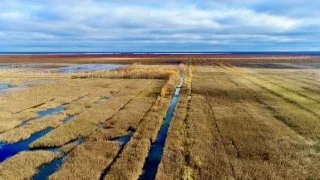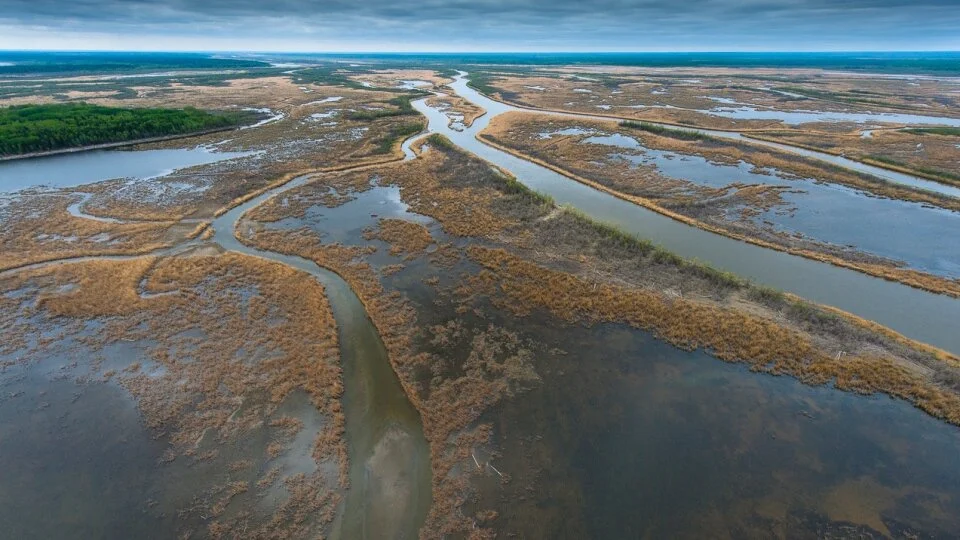A historic deal signed Friday will protect 30 per cent of B.C.’s lands and waters by 2030. The Trilateral Framework Agreement was signed between the federal and British Columbia governments and the Indigenous-led First Nations Leadership Council. With this agreement, the federal government will be contributing $500 million and the B.C. government has dedicated more than $500 million, which includes a fund for old-growth forests and the opportunity for additional funds from the philanthropic community. The agreement includes a commitment to work together toward protecting 25 per cent by 2025, including on Indigenous protected areas.
Action needed as Canada loses nearly 300 football fields of grasslands daily
Canada’s iconic Prairie grasslands are in peril, but the Nature Conservancy of Canada (NCC) has sprung into action to try to save the vital ecosystems. Its Prairie Grasslands Action Plan proposes to conserve more than 500,000 hectares (more than 5,000 square kilometres) by 2030 —- six times the size of Calgary. In a recent interview with The Weather Network, Jeremy Hogan, NCC's director of prairie grassland conservation, said only 18 per cent of Canada's original grasslands remain. "We have taken the grasslands for granted a little bit. They're one of our most productive ecosystems in terms of food production, but also services like water storage, filtration [and] preventing droughts and floods," said Hogan.
This grad’s economics degree will add up to better environmental policies in Canada and beyond
Meghan Lim loves both nature and numbers, and hopes that by combining those passions, she can help protect the planet. With an eye to using her skills to support climate action, the newly minted economist graduates June 13 with a master of science in agricultural and resource economics — a degree she considers a perfect fit for her desire to make a difference through conservation and sustainable development. “I found my niche in the interface of conservation and policy and dealing with numbers and statistics,” Lim says about the program, offered through the Faculty of Agricultural, Life & Environmental Sciences (ALES).
Dress code for a happier planet
Consumers are increasingly worried about climate change, the fashion industry’s contribution to pollution and plastics and its terrible human rights track record. Fashion adds 10 per cent of the globe's greenhouse gas emissions and this will rise to 50 per cent if left unchecked. It takes 700 gallons of water to make one cotton T-shirt and that water is polluted by the time it is returned to the water table. Ninety-seven per cent of our clothes are made in the Global South by people working in slave-like conditions who are paid less than their country’s living wage.
Dry weather leads to low water levels near Edmonton, residents asked to conserve
Businesses and people living west of Edmonton are being asked to limit water use amid hot, dry weather. The City of St. Albert, Alta., asked residents and business owners to conserve water Monday. The three reservoirs that store water for community use and fire protection are at “near critical” levels, according to the city.
Biodiversity loss is threatening Canada’s wetlands; here’s why it matters
The swamps of the Minesing Wetlands, a 15,000-acre area about 15 kilometres west of Barrie, Ont., are not the most immediately welcoming of places. Convincing someone to spend a day exploring the thick, forested marshes—with clouds of mosquitoes in the air and bloodsucking leeches in the water—isn’t easy. I should know. I’ve been trying to convince friends to join me on a trip there for years. Again and again, my attempts are met with two questions: why would I visit, and why should I care?
Ross River Dena propose Indigenous protected area in Yukon
The Ross River Dena Council is doubling down on work to establish an Indigenous Protected and Conserved Area, according to the First Nation's chief. "It's a pretty important area that we need to conserve to protect our interests for future generations," Dylan Loblaw told CBC News. "We need to have that balance." According to a funding proposal to the Canada Nature Fund, the First Nation wants to protect roughly 41,000 square-kilometres in central-east Yukon. The proposed area would extend from the Pelly River valley to the Selwyn-Mackenzie Mountains along the continental divide. The First Nation's group trapline — used by community members for generations — comprises a significant portion.
A second chance to protect wetlands
Wetlands are among the most threatened ecosystems in the world. A new study, published in Nature, has found that the loss of wetland areas around the globe since 1700 has likely been overestimated. This is good news overall, however, the global picture hides significant variations, with several regions and distinct wetland types under significant levels of pressure. For instance, temperate river floodplains have been highly impacted while remote boreal-arctic peatlands remain comparatively unharmed. While wetland conversion and degradation has slowed globally, it continues apace in some regions, such as Indonesia, where large swaths of land are being cleared for oil palm plantations and other agricultural uses. This new global perspective on wetland loss can help prioritize conservation and restoration actions.
Nature Conservancy of Canada purchases land for protection in southern Alberta
The announcement comes a few months after the organization announced a $6.9-million campaign to save a 16.5-square-kilometre property called the Yarrow, which is also in southern Alberta but "a little farther north" from the latest project and just outside what's traditionally known as the Waterton Park Front. The Yarrow also features grasslands, wetlands, creeks, mixed forests and includes 27 wildlife species of provincial and national significance. There are two streams that provide fish habitat and transport water from Alberta's southern headwaters to rivers across the Prairies that flow to Lake Winnipeg and eventually Hudson Bay.
Great Bear Lake agreement gives 'us the ability to actually sit at the table, says Délįnę chief
The Délįnę Got'įnę government and its federal and territorial counterparts have agreed on further protection for Great Bear Lake or TsáTué, a UNESCO-recognized biosphere reserve. The new agreement will enhance conservation of the area and will lead to long-term funding. It also formally recognizes the Sahtugot'ine's millennia-long stewardship in the Northwest Territories region. "It's a step in the right direction," said Danny Gaudet, the Délįnę Got'įnę government's Ɂek'wahtı̨dǝ́ or chief. "It's finally given us the ability to actually sit at the table to talk about the preservation of water, the lake, and the water bed and the land in and around Great Bear Lake."
Canada welcomes the world for COP15 to protect nature
From the red sand beaches of Prince Edward Island in the Atlantic, to the snow-capped Rockies in the West, to the permafrost that covers much of the Canadian Arctic – Canada is known for our landscapes. Nature is part of who we are as Canadians, but it is under threat. Today, we are welcoming the world to Canada to make sure nature remains part of who we will be for generations to come.
In time of climate crisis, Manitoba unveils new water strategy
From nutrient-rich wetlands and 100,000 lakes to a dry southern region and an Arctic port, Manitoba is a province defined by water — after all, nearly a fifth of the province is covered in it. Now, in an update nearly 20 years in the waiting, the Manitoba government has released a strategy to manage its water resources — factoring in the impacts of a warming climate for the first time.
Manitoba's new water strategy: Limit its use
Manitoba is unveiling a new water strategy that emphasizes conservation — and floats the idea of a new pricing system. The provincial Progressive Conservative government released a strategy on Tuesday that will, in broad strokes, guide Manitoba's actions to protect its water resources for years to come. The province said it will develop an action plan this winter to determine its future decisions. The strategy vows to "make every drop count" by valuing the province's water resources. "The focus needs to shift from supply-side management solutions to approaches that reduce how much water we use," the strategy reads.
Plan to create vast B.C. network of protected ocean opens to public
A plan to create a vast network of marine protected areas stretching from Vancouver Island to the Alaskan border inched closer to reality this Monday after the governments of Canada, British Columbia and over a dozen First Nations released a draft plan to the public. If enacted, the marine protected areas (MPAs) would protect nearly a third of the Northern Shelf Bioregion — a 100,000-square-kilometre tract of ocean also known as the Great Bear Sea.
Wetlands are a natural remedy for Canada’s sick lakes
Chances are high that you saw it over the summer at your favourite lake: thick scum on the water’s surface, often resembling pea soup. Blue-green algae (also called cyanobacteria) can render water unsafe for swimming and often makes people, pets, livestock, and wildlife sick. In July, Nova Scotia listed 26 waterways suspected to have blue-green algae blooms. Officials with Alberta Health Services identified blue-green algae in areas of Camp Lake, east of Edmonton, and Haunted Lake (an ironic name for a place fouled by the sinister sludge), east of Red Deer. The Saskatchewan Health Authority issued a blue-green algae warning for Little Manitou Lake, southeast of Saskatoon. British Columbia’s Capital Regional District saw toxic algae blooms in three different lakes across two regional parks in August.
North Bay's Canadore College gets $750K for a clean water lodge
North Bay's Canadore College has received $750,000 from FedNor to build an Indigenous clean water learning lodge. The lodge will be a testing ground for water treatment technology, and will also apply Indigenous knowledge around conservation. The funding announcement was part of a $2.8-million investment to support four initiatives at the northern Ontario college.
Federal promises to expand the protection of land and water are empty without budget commitments
The federal government is hard at work finalizing a budget that will underwrite our path forward out of the pandemic as a country. That's why 50 women leaders from diverse regions and sectors, and across Indigenous, Black, racialized and LGBTQ2IS+ communities, are writing to Finance Minister Chrystia Freeland this week to remind her that nature's recovery is essential to our own.
Opinion: Indigenous-led conservation the key to sustainable development
Canada’s economy is showing early signs of recovery. The labour market is expanding, government leaders are preparing to release the first federal budget in two years, and companies are identifying post-pandemic investment strategies. In this still-tentative time, some people will claim that a full recovery requires trade-offs. They will say we must prioritize jobs over the environment, industry over Indigenous Nations, and short-term growth over lasting climate solutions. But those are false choices.
Yukon pushed to develop protections for irreplaceable wetlands threatened by mining
An independent panel is urging the Yukon government to develop a wetlands policy to protect unique streams, bogs, fens and peatland from mining because there are no known ways to fully restore these sensitive ecosystems once disturbed. Wetlands filter water, provide habitat to species and sequester carbon but are quickly being lost to development worldwide — an issue drawing attention on World Wetlands Day Feb. 2.
World Wetlands Day focused on improving awareness, protection for Sask. ecosystems
Experts are hoping World Wetlands Day gets people interested in protecting the shrinking ecosystems in Canada’s wetlands. Wetlands, both temporary and permanent, serve as a natural filter for larger bodies of water, replenish renewable water resources and serve as a home to many species. "The wetlands do all these things and it's pretty easy to forget that," said Peter Leavitt, Canada Research Chair. Jeff Olson, managing director at Citizens Environmental Alliance, said it is important to remember all the good these areas do, but to also mourn the ones we have lost.





















